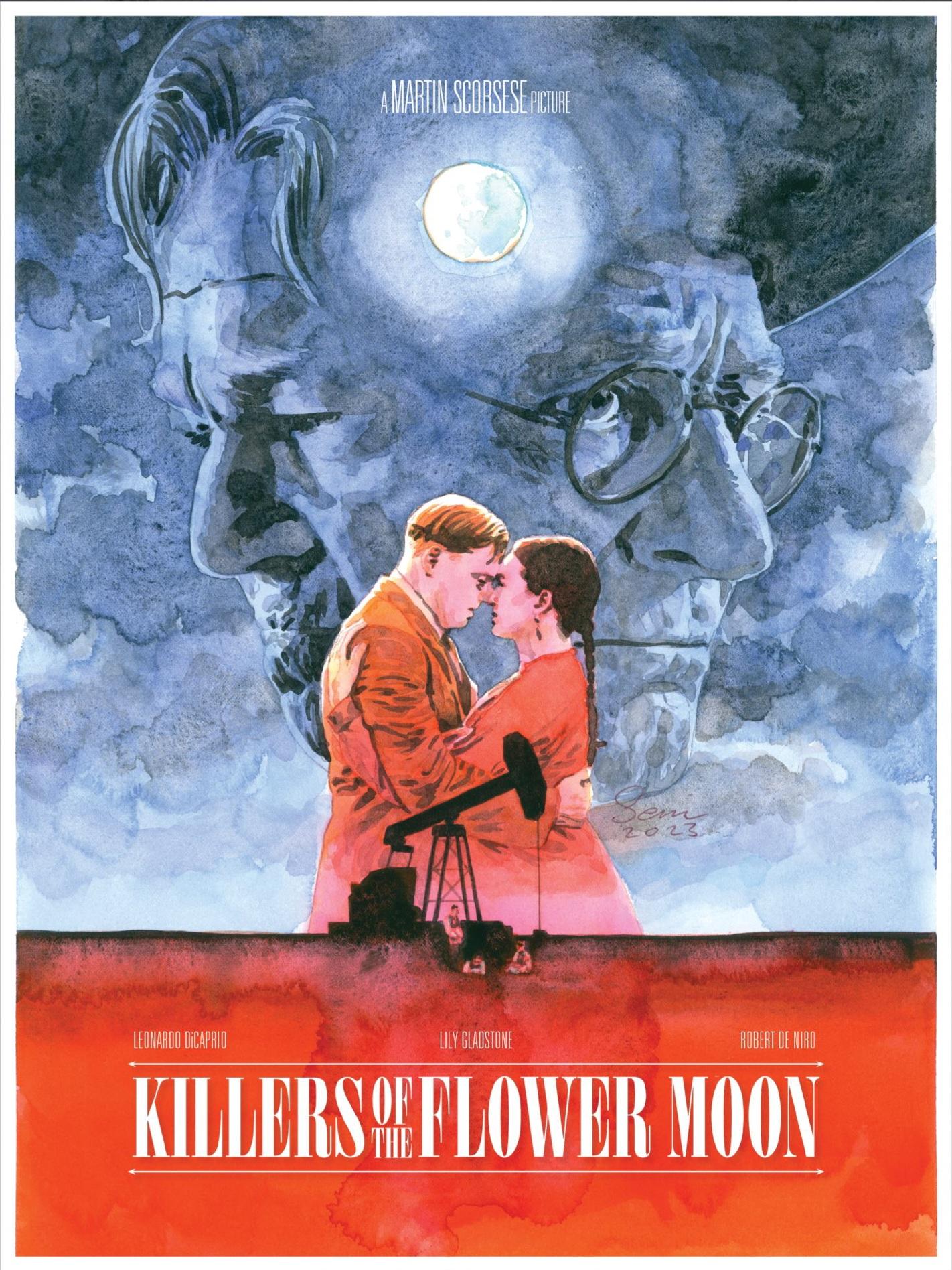Written by Margaret Rasberry October 17, 2023
A long tracking shot follows the ground as the score pulsates with percussive Powow drumming representing the budding oil deposits flowing underground ,courtesy of the dearly departed composer Robbie Robertson, until the oil rises from the earth, creating a geyser of black fluid which under the sunlight, is transformed into a golden hue, seen from an aerial shot. Liquid gold has emerged from the Earth, enriching the Native Osage people, and as they dance in the liquid gold, their bodies dripping with the black fluid, they have become like the oil, a resource for the Euro American settlers to exploit for their avarice and dominance of the land and its people. In 1924, US President Calvin Coolidge signed into law The Indian Citizenship Act the provided full citizenship to Native Americans for the first time, and it is in the shadow of this societal transition, where Indigenous Americans have abruptly become in Federal law, finally full citizens of their Native Land, and in this county, many of these members of the Osage tribe have become the wealthiest citizens of the United States, and Scorsese conveys this epoch with such adroitness, you feel you are witnessing history come alive before your very eyes.

When you watch a Scorsese picture, you are not just simply “watching” a movie. You are experiencing decades of a director constantly refining his craft before your very eyes. Scorsese and his team imbue every facet of his films with intensely crafted realism that adds to the verisimilitude of the picture, with racist iconography placed in the background of shots of insidious whites, from the old timey 1920’s reels that evoke the News on the March scene in Citizen Kane of Osage citizens riding in rollsters and adorned with the finest furs and brightest and cleanest adornments signifying their wealth, which will set the stage for the acrimonious dichotomy between the nouveau riche Osage people to the white settlers in the Osage county in Oklahoma during the early 1920s.
The film conveys the tragic true story of Mollie Burkhart (Lily Gladstone), an Osage native of Osage county Oklahoma, who has found herself as one of the wealthiest people in the country, with her mother Lizzie Q (Tantoo Cardinal) and sisters Anna, Reta, and Minnie (Cara Jade Myers, JaNae Collins, and Jillion Dion) becoming the objects of conquest by white men in the county including Mollie’s eventual husband Ernest Burkhart (Leonardo DiCaprio) a fecklessly obsequious former veteran hopes to ingratiate himself with his uncle William King Hale (Robert DeNiro) the self described Deputy Sheriff who proudly boasts of being friends with the Osage people, all while secretly consorting with Ernest and his brother Bryan to systematically wipe out the rich Osage people, including Mollie’s family, to steal their oil rich land, the consequences of which still reverberate. “This blanket is a target on our backs” Mollie conveys in one of her few inner monologues that punctuate the severity of being a member of the Osage people in the wolves den, as Mollie is strategically gastlit by her husband and his family, Gladstone imbues her character with engrossing paranoia in a heart wrenchingly superbly acted award winning performance.

Every murder in the film is palpable, as the film posits the pertinent family and communal bonds in the Osage tribe. American individualism is not more important than the tribe, a morality that is unfathomable to men like Ernest and William. When Mollie loses members of her family, a piece of herself withers for every member, a costly burden Gladstone carries with her in every scene. I could feel my furor watching as Mollie is endangered, Osage are killed, and every white person in a position of power knowing they will easily get away with it, as no authority responds to the Osage tribes’ pleas for help. “We never prayed for the great life, we just wanted life”, the chief of the tribe posists in the film, a sentiment that still resonates as Native Americans still face higher death rates than white people.
Providing a backdrop to this narrative is the investigation of the murders headed by the newly formed Bureau of Investigation, led by agent Tom White (Jesse Plemons), which forms the main plot of the book by David Grann, which Scorsese and co-writer Eric Roth wisely chose to reduce for the main film as the true story of Mollie Burkhart and the murder of her relatives and friends is the focal point of this tragically neglected and buried part of American history. Tom White is no white savior, as Scorsese knows his audience is wise to these Americanised conventions, as he deftly deconstructs the white cowboy hero of Westerns, presenting White as an arbitrator of justice, with racial biases of his own.

Scorsese presents the true malignancy of racial injustice and prejudice lies not within racist individuals, but systems of power run by figures upholding white supremacist ideals kept in power by white apathy and antipathy of minorities by regular white citizens. Scorsese shines a light on the complacency of white individuals is what truly leads to the murders of these families. The apathy towards the history of Native Americans is a stain on America, and only now have we begun to truly scratch the surface of.
Killers of the Flower Moon is a revelation, with the over three hour runtime nevering feeling languidly paced, with every second counting towards the finely tuned narrative engagingly edited by long time Scorsese collaborator Thelma Schoonmaker. Expertly shot by Rodrigo Prieto, with precise point of view shots and tracking shots submerging the audience into the world Scorsese has crafted, Killers of the Flower Moon is destined to be one of Scorsese’s crowning achievements to cinema history.
Grade: A
Killers of the Flower Moon is set to be released theatrically October 20th, 2023, courtesy of Paramount and Apple Originals.
